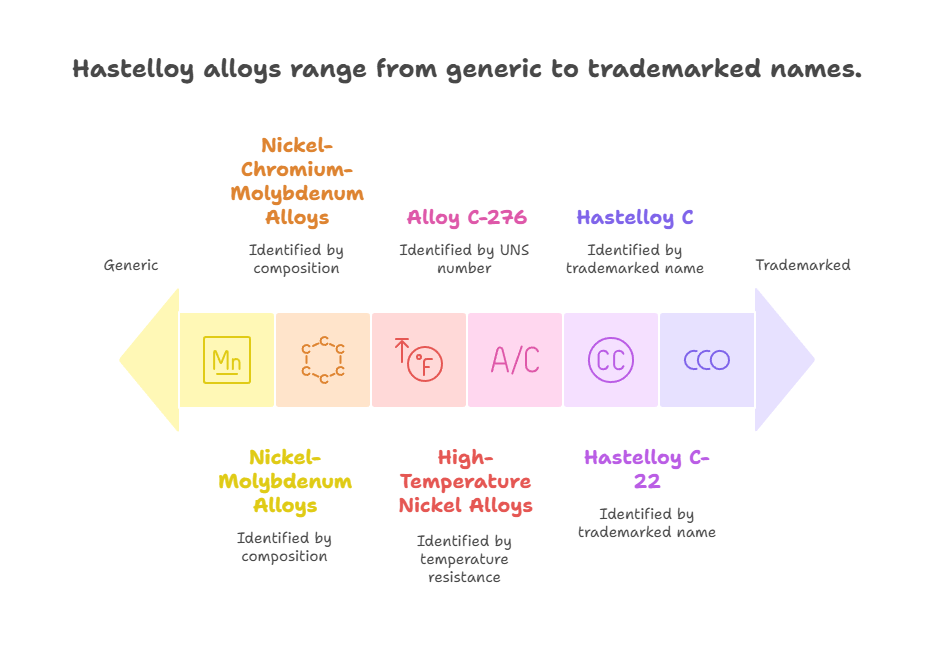Hastelloy is a trademarked name representing a family of corrosion-resistant metal alloys primarily composed of nickel, along with varying amounts of molybdenum, chromium, cobalt, and iron. These alloys are produced by Haynes International and are widely used in chemical processing, marine engineering, power generation, and aerospace industries. However, in different industrial contexts and international markets, Hastelloy is often referred to by alternative names, UNS numbers, or generic alloy group descriptions. Understanding these alternative identifiers is crucial for engineers, buyers, and fabricators who operate across global supply chains.

Understanding the Hastelloy Trademark
The term “Hastelloy” itself is a registered trademark of Haynes International, a U.S.-based manufacturer of high-performance alloys. This means that only alloys produced and certified by Haynes can officially bear the Hastelloy name. Other manufacturers may produce similar alloys with identical chemical compositions, but they cannot legally market them as Hastelloy. Instead, these products are often identified using their UNS (Unified Numbering System) designations or ASTM material numbers.
Alternative Names for Hastelloy Grades
The following table lists popular Hastelloy grades along with their UNS numbers and commonly used alternative names:
| Hastelloy Grade | UNS Number | Common Alternative Names |
|---|---|---|
| Hastelloy C | N10002 | Nickel-Molybdenum Alloy |
| Hastelloy C-22 | N06022 | Alloy 22, Nickel Alloy C-22 |
| Hastelloy C-276 | N10276 | Alloy C-276, UNS N10276 |
| Hastelloy C-2000 | N06200 | Nickel-Chromium-Molybdenum-Copper Alloy |
| Hastelloy B | N10001 | Nickel-Molybdenum Alloy B |
| Hastelloy X | N06002 | Alloy X, Nickel Alloy X |
Generic Names and Descriptions
In industries that do not rely on branded material names, Hastelloy alloys are frequently referred to by more generic terms based on their chemical composition and function:
| Generic Description | Examples of Hastelloy Grades |
|---|---|
| Nickel-Molybdenum Alloys | Hastelloy B, B-2, B-3 |
| Nickel-Chromium-Molybdenum Alloys | Hastelloy C, C-22, C-276, C-2000 |
| High-Temperature Nickel Alloys | Hastelloy X |
International Equivalents and Cross-References
Some countries and material standards organizations use different names to refer to materials equivalent to Hastelloy alloys. Understanding these cross-references is essential for international procurement:
| Standard | Hastelloy Equivalent | Notes |
|---|---|---|
| ASTM | ASTM B622, B619, B575 (varies by grade) | Material and dimensional standards |
| EN (Europe) | 2.4819 (C-276) | EN equivalents for welding wire and pipe |
| DIN | NiMo16Cr15W (C-276) | Used in German material specifications |
| ISO | ISO NW 0276 | International designation for C-276 |
Why Alternative Names Are Used
There are several reasons why industries and suppliers use alternative names instead of the Hastelloy trademark:
| Reason | Explanation |
|---|---|
| Trademark Limitations | Only Haynes International can officially use the Hastelloy name. |
| Standardization | Using UNS or EN numbers provides a universal identifier for global trade. |
| Cost and Sourcing | Other manufacturers offer equivalent alloys without the Hastelloy branding, often at lower cost. |
| Specification Requirements | Certain contracts specify UNS or ASTM standards rather than brand names. |
How to Identify Hastelloy Equivalent Alloys
If you’re trying to find a material equivalent to a branded Hastelloy alloy, follow these steps:
| Step | Action | Purpose |
|---|---|---|
| 1 | Identify the UNS number (e.g., N10276) | Allows cross-referencing across suppliers and standards |
| 2 | Check applicable ASTM or EN standard | Ensures dimensional and mechanical compliance |
| 3 | Consult material datasheets | Compare chemical composition and corrosion resistance |
| 4 | Verify testing certifications | Ensure material traceability and performance |
FAQ: Related Questions
Is Hastelloy the same as Alloy C-276?
Yes, Hastelloy C-276 is a specific grade within the Hastelloy family, and it is also known as Alloy C-276 or by its UNS number N10276. It is one of the most widely used nickel alloys for corrosion resistance.
Can I use UNS N10276 instead of Hastelloy C-276?
Yes, UNS N10276 is the standard identifier for Hastelloy C-276 and can be used interchangeably in specifications. However, ensure the supplier can provide full documentation and meets the required standards.
Are there cheaper alternatives to Hastelloy?
Yes, depending on the application, other alloys such as 254 SMO, Inconel 625, or even duplex stainless steels may serve as alternatives. However, these should only be used if corrosion and temperature resistance requirements are adequately met.



